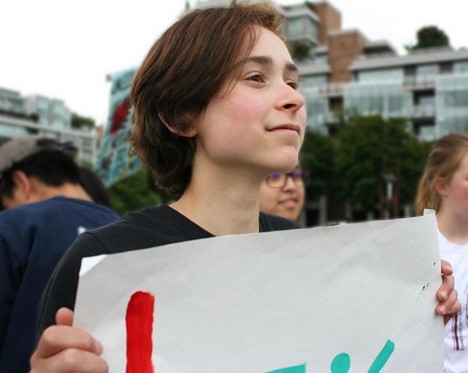by Julia Townsend

When Lola Rabinovitch organized their first school strike at 16, they never imagined it growing into Metro Vancouver’s largest youth climate action group. The now 19-year-old sees a shift in climate activism, with the spotlight turning to financial investments and industry.
Sustainabiliteens mobilized residents at some of the largest protests in the city’s history. After two years of pandemic disruption, they are back in the streets calling on governments to act on climate change. On March 25, these young people joined cities across the globe by marching in Vancouver as part of the #PeopleNotProfit Global Climate Strike. They drew attention to the Canadian banks funding the fossil fuel industry and want to hold governments accountable to their promises.
“It’s people just like you and me. It’s not activists with years of frontline experience, or political scientists with PhDs — it’s just students doing what they can,” Rabinovitch says.
Sustainabiliteens began as a response to growing concerns from local teens. On Jan. 16, 2019, an estimated 50 Vancouver high school students rallied outside of Vancouver City Hall to pressure the city to act on climate change. The next day, Vancouver City Council voted unanimously on a motion declaring a climate emergency.
Rebecca Hamilton and Rabinovitch, both 16 at the time, organized the rally. They went on to form SusteensBC, which is now known as Sustainabiliteens.
The small group of students felt inspired by the rise of school strikes worldwide. They learned how to hold a climate strike by watching other young people, like Swedish activist Greta Thunberg.
Thunberg influenced their protests and gave momentum to the movement, Rabinovitch says.
By September 2019, Sustainabiliteens organized several demonstrations bringing 120,000 people to the streets of Vancouver. They continued to grow in size and structure. A month later, the group hosted Thunberg and Canadian environmentalist David Suzuki at a 15,000-person rally at the Vancouver Art Gallery.
Their focus during the pandemic shifted from government pressure to financial sector investments in the fossil fuel industry.
“RBC (the Royal Bank of Canada) is the largest financer of fossil fuels in Canada and the fifth largest in the world,” says Naisha Khan, a core organizer for Sustainabiliteens. “Knowing this, we realized climate finance was the next tangible thing we wanted to explore.”
Khan and Hamilton envisioned creating an organization that drew attention to the Canadian banks financing the oil, gas and tar sands industries and pressured them to divest. Last January, they proposed the idea of “Banking on a Better Future” to Climate Strike Canada, a national climate advocacy group for young people.
“We know that RBC is very sensitive to threats, especially with projects that violate Indigenous sovereignty, like the Coastal GasLink pipeline. Doing things like this will definitely call attention to that and hopefully pressure them to deeply examine their practices and understand that climate risk is also a social and investment risk,” Khan says.
Climate Strike Canada agreed to work with Khan and Hamilton, and Banking on a Better Future was born.
On the eve of the 2021 United Nations Climate Change Conference (COP26) last October, Banking on a Better Future collaborated with Sustainabiliteens for their organization’s first event, the RBC Global Day of Action.
Rabinovitch held a 40-foot inflatable of David McKay, CEO of RBC, while Khan spoke to the crowd about intersectionality and decolonization in the climate justice movement. They presented the inflatable of McKay with satirical awards for his bank’s financing of the Coastal GasLink pipeline.
Rabinovitch and Khan say projects like the Coastal GasLink pipeline directly involve Indigenous peoples. The pipeline runs from Dawson Creek to a facility in Kitimat, B.C., and is the subject of ongoing Wet’suwet’en opposition.
“One of our central focuses has become including the work of Indigenous peoples in our activism. Sometimes people will think the two are separate, but really, the origin is the same,” Rabinovitch says. “If you’re protesting climate change, chances are Indigenous groups are affected by it and protesting too.”
Khan says the voices of historically marginalized groups need to be uplifted the most.
“We don’t need white people to say, ‘we are a voice for the voiceless.’ We need … our voices to be centred,” Khan says. “By uplifting the voices most impacted by climate change, I think we’re really getting at the root causes of the climate crisis.”
The tone of Sustainabiliteens’ March 25 protest differed from anything they did pre-pandemic. While past demonstrations called on governments to act on climate change, future demonstrations will publicly criticize specific individuals and institutions investing in the fossil fuel industry.
“We’re not just fighting for some kids’ futures. We’re fighting for people’s livelihoods right now,” Khan says.
This story was written as a part of JRNL 2240: Beyond the News: Feature Writing, a Climate+ Challenge course.